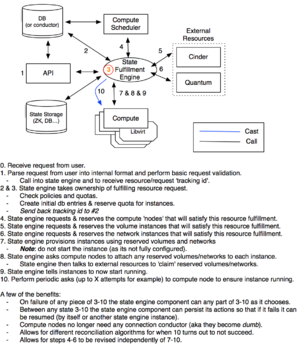Difference between revisions of "StructuredStateManagement"
(→Summary) |
(→Summary) |
||
| Line 53: | Line 53: | ||
=== Plan of record === | === Plan of record === | ||
| − | ==== Step 1 === | + | ==== Step 1 ==== |
# Create prototype | # Create prototype | ||
Revision as of 00:35, 25 April 2013
Contents
- 1 Summary
- 2 Design
Summary
Move away from ad-hoc states and state transitions for resource acquisition and modification to a more concrete organized structured state management system in nova.
What problems does this solve in general
- Increases the [stability, extendability, reliability] of the various openstack projects.
- Makes it easier to [debug, test, understand, verify, review] the projects which have a workflow-like concept.
- Removes hard to discover state-transition dependencies and interactions with clearly defined state-transition dependencies and interactions.
- Ensures state transitions are done reliably and correctly by isolating those transitions to a single place/entity.
- Fixes a variety of problems that previously had piecemeal like patches applied to attempt to solve them (avoiding fixing the larger problem).
- Eliminates the inherent fragility of the current ad-hoc workflows that exist in the openstack projects.
- They are by there ad-hoc nature hard to debug, hard to verify, hard to adjust, hard to understand (just hard in general)...
- Makes it possible to audit & track the state transitions performed on a given resource.
- This kind of functionality has started to appear in nova, but the ad-hoc nature was preserved :-(
- Addresses the underlying key point of http://www.slideshare.net/harlowja/nova-states-summit/9 where states will now be fully recovered from on cutting.
What problems does this solve in nova (+ the general ones)
- Removes the need for periodic tasks to cleanup garbage (orphaned instances, orphaned resources...) left by nova's ad-hoc states.
- Creates the path for smart resource scheduling.
- Makes it possible to do [resizing, live migration] in a more secure and manageable manner.
- Discussion about how this can be done correctly require a intermediary to orchestrate this ownership transfer.
- Makes it possible for nova to have multi-stage booting where an instances and its dependent resources are first reserved, the resources configured, the instance configured, and then finally the instance is powered-on (thus completing the instance provisioning process).
Issues that would likely not have happened with a better state management system
- https://blueprints.launchpad.net/nova/+spec/compute-instance-cleanup-service
- https://bugs.launchpad.net/nova/+bug/1050979
- https://bugs.launchpad.net/nova/+bug/1061024
- https://bugs.launchpad.net/nova/+bug/1082414
- ...
Connected blueprints
Connected wikis
https://wiki.openstack.org/wiki/Convection
Requirements
https://etherpad.openstack.org/task-system
Discussions
https://etherpad.openstack.org/the-future-of-orch
Plan of record
Step 1
- Create prototype
- Create library and use said library in nova for run_instance action in nova.
Step 2
- Get feedback on prototype.
- Get feedback from summit session.
- Get more feedback from email list + other interested parties.
Step 3
- Adjust nova prototype as needed from feedback.
- Split nova prototype into small chunks.
- Adjust tests for each small chunks (depending on what it changes).
- Submit chunks into http://review.openstack.org (disabling whole/pieces component until ready to turn on?).
Step 4
- Pick another nova action and refactor it to use design from prototype
- Split this other action (refactored) into small chunks.
- Adjust tests for each small chunks (depending on what it changes).
- Submit chunks into http://review.openstack.org (disabling whole/pieces component until ready to turn on?).
- Repeat
Prototype
https://github.com/Yahoo/NovaOrc
Design
Design details
In order to implement of this new orchestration layer the following key concepts must be built into the design from the start.
- A set of atomic tasks that can be organized into a workflow.
- Task resumption.
- Task rollback.
- Task tracking.
- Resource locking.
- Workflow sharding/ownership.
- Simplicity (allowing for extension and verifiability).
- Tolerant to upgrades.
Atomic tasks
Why it matters
Tasks that are created (either via code or other operation) must be atomic so that the task as a unit can be said to have completed or the task as a unit can be said to have failed. This allows for said task to be rolled back as a unit. It is also useful to be able to be able to accurately track exactly what tasks have been applied to a given workflow, which is inherently useful for correct status tracking (and is directly tied to how resumption is done).
How it will be addressed
Tasks which previously were very unorganized in the run_instance path of nova will need to be refactored into clearly defined tasks (likely with an apply() method and a rollback() method). These tasks will be split up so that each task performs a clear single piece of work in an atomic manner (aka not one big task that does many different things) where possible. This will also help make testing of said task easier (since it will have a clear set of inputs and a clear set of expected outputs/side-effects, of which the rollback() method should undo).

